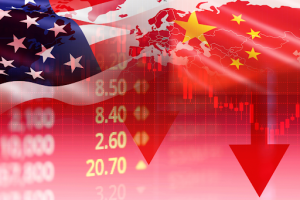Exploring the Impact of US Tariffs on Manufacturing in China 2025
In 2025, the United States significantly escalated its trade measures against China, imposing a series of tariffs that will profoundly impact Chinese manufacturing. These tariffs, coupled with China’s strategic responses, have reshaped the global manufacturing landscape.
This article explains the details about the specifics of the US tariffs, their repercussions on China’s manufacturing sector, and the strategies China is employing to mitigate its reliance on the US market.
What Are Tariffs?
Tariffs are extra charges or taxes that a government puts on products that come from another country. This means when something is imported such as clothes, electronics, or toys from outside the country, the business bringing it in has to pay extra money to the government.
For example, if a company in the US buys phones from China to sell in American stores, the US government might charge a fee on each phone. This fee is the tariff. The company usually adds this cost to the price, so customers end up paying more.
Governments use tariffs for different reasons. Sometimes, they protect local businesses by making foreign products more expensive, which may encourage people to buy local products instead.
What Are US Tariffs on China?
Tariffs have been a core tool in the US’s trade approach toward China, targeting issues like trade deficits and intellectual property theft. In 2018 President Trump initiated the trade war, citing unfair trade practices and intellectual property theft.
In 2025, under President Trump’s second term, the US imposed steep new tariffs. Starting with 10% on all Chinese imports in February, they rose to 20% in March, followed by dramatic sector-specific hikes in April, reaching a cumulative 145% on some goods.
Here is the summary of the tariffs announced by the US on China:
| Date | Sector | Tariffs | Total Tariffs |
|---|---|---|---|
| 2018 | Solar panels, washing machines, steel, aluminium, electronics | 10%-50% | Up to 50% |
| 2025 February | All Chinese Imports | 10% | 10% |
| 2025 March | All Chinese Imports | 20% | 30% |
| 2025 April (Start) | High Tech (Electronics, Semi-conductors) | 34% | 64% |
| 2025 April (Mid) | All Imports (universal), Pharmaceuticals (planned) | 10% universal, 54% effective on China | 145% |
Read more details about these tariffs at this link.

Key Elements of US Tariffs on China in 2025
On April 2, 2025, President Donald Trump declared ‘Liberation Day,’ announcing a comprehensive tariff regime. Subsequently, on April 8, the administration increased tariffs on Chinese imports to a cumulative 145%, significantly impacting various sectors. The US tariffs on China include:
- 10% Universal Tariff: Applied broadly to all Chinese imports.
- 54% Reciprocal Tariff on Chinese Goods: This additional tariff is specifically aimed at Chinese goods that are perceived to be unfairly priced or subsidized. It includes categories like electronics, textiles, and more.
- Additional Sector-Specific Tariffs: Sector-specific tariffs are targeted import taxes applied only to goods from certain industries or sectors rather than uniformly across all products. Like various sectors, such as solar panels, machinery, and certain technology items
- Intellectual Property Tariffs: Section 301 tariffs also continue to penalize Chinese goods that are believed to be benefiting from intellectual property theft or forced technology transfers.
These tariffs reflect a larger strategy to reduce China’s trade surplus, shift global supply chains, and limit China’s technological and manufacturing influence worldwide.
Note: The tariffs on UK goods are significantly lower than those on Chinese imports. As of April 2025, Chinese products face up to 145% tariffs, while UK goods generally face only 10%, with 25% on steel, aluminum, and vehicles. This makes the UK a strategic, low-tariff alternative for manufacturing businesses looking to reduce import costs.
Immediate Effects of Tariffs on China’s Manufacturing Sector
The effects of these tariffs on China’s manufacturing industry will be substantial, no doubt about that. Below are the most significant immediate impacts that were observed in 2025 recently:
-
Export Decline
One of the tariffs’ most direct impacts will be the decline in China’s exports to the US. Many
Analysts projected that China’s exports to the US would decrease by as much as 30% over the next few years and cut overall exports by 4.5%. With the tariff increase to 145% in April, these projections may be further exacerbated.

-
Economic Growth Challenges
China’s economy, which had previously grown at impressive rates, began to show signs of slowdown due to the tariffs. The manufacturing sector, which forms the backbone of China’s economic growth, was particularly hard-hit. The tariffs were anticipated to drag China’s GDP growth down by 1 to 2 percentage points in 2025, underscoring the severity of the economic impact.
-
Supply Chain Disruptions
Chinese factories relying on US components face rising costs and delays. Shifting operations to countries like Vietnam and Malaysia hasn’t helped much, as new US tariffs now extend to those regions, too.
Economic Impacts on Chinese Manufacturers
The immediate impact of the renewed tariffs in 2025 on Chinese manufacturers has been significant. The steep US levies, now totaling 145%, severely squeeze the profit margins of Chinese exporters, forcing difficult adjustments.
Many exporters cannot easily absorb these tariffs without raising prices or cutting costs, which threatens their competitiveness in the US market.
As reported by Reuters, Chinese firms have reacted by scrambling to reduce expenses and reconfigure operations. For instance, a Chinese factory owner producing cast-iron bathtubs reported he “laid off some employees, reduced management costs, and cut down on various expenses” in early 2025 to cope with shrinking foreign orders.
Some Chinese companies tried relocating production to other countries to evade US tariffs, a strategy that accelerated during the trade war and continued after 2018. For example, manufacturers opened factories in Vietnam, Malaysia, and elsewhere to ship tariff-free to the US. However, the new US trade measures in 2025, including “worldwide” tariffs, undercut this strategy.
Which Products Will Become Expensive Due to US Tariffs on China?
Many key US industries rely heavily on Chinese imports, and some of these will be highly affected by these new tariffs, which will make their products even more expensive for consumers:
- Manufacturing: Heavy Machinery and Automobiles
Manufacturers are among the industries most affected by tariffs, especially those relying on imported components. Automobiles, heavy machinery, and consumer electronics are extremely dependent on global supply chains, making them highly vulnerable to tariff increases.
For Chinese manufacturers aiming to pivot and secure more stable operations outside of U.S.-China trade routes, Kirmell offers dedicated support through its Manufacturing and Industrial Services. Specializing in precision engineering, Kirmell provides services such as presswork, fabrication, CNC machining, laser cutting, and welding.
By partnering with Kirmell, businesses can enhance their supply chain resilience and establish a reliable presence in the UK market. Contact us now for more information.

- Electronics like iPhones and TVs
Since the vast majority of iPhones are still manufactured in China, the 54% reciprocal tariff means that products manufactured there and imported into the United States will be more expensive than before.
- Agriculture
Agricultural products are one of the most important markets for US products, but China retaliated against US tariffs by imposing its duties on them, significantly reducing demand.
The retaliatory tariffs drastically reduced sales of soybeans in the United States, which rely heavily on exports to China.
According to the American Soybean Association, soybeans will face a 60% tariff in China starting next week, double what they faced during the 2018 trade war.
Kirmell: Your Gateway to the UK Market
If you’re a Chinese manufacturer or global business impacted by the new U.S. tariffs, Kirmell can support your supply chain needs with dependable, UK-based industrial services.
What Kirmell Offers:
- Precision Manufacturing Services – Presswork, laser cutting, CNC machining, and fabrication tailored to your specifications
- Supply Chain Partnership – Connect with a trusted UK partner to source high-quality components and ensure production continuity
- Prototype & Development Support – Access rapid prototyping, tooling, and engineering services to bring products to market faster
- Export-Focused Capabilities – ISO 9001:2015 certified manufacturing with reliable lead times and experience serving international clients
Visit Kirmell’s official website to connect with experts, or fill out our Contact Us form to start a consultation.
Conclusion
The US tariffs imposed on Chinese goods in 2025 will have a profound effect on China’s manufacturing sector. With diminished access to the US market, increased competition in global markets, and the threat of economic slowdown, Chinese manufacturers are facing considerable challenges.
Yet, this shift has opened doors for forward-thinking businesses. With the UK exempt from new tariffs, manufacturers can explore new opportunities with support from partners like Kirmell, offering a roadmap to resilience and international expansion in an evolving trade landscape.
FAQ’s
What are the current US tariffs on Chinese goods?
How much is the tariff on Chinese goods in 2025?
Are there alternative markets to the US for Chinese manufacturers?
What are the current UK tariffs on Chinese goods?


Leave a Reply
Want to join the discussion?Feel free to contribute!